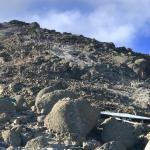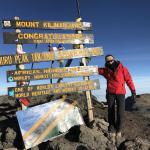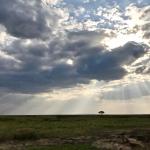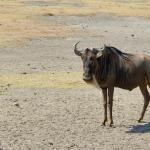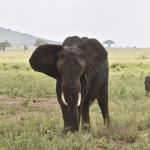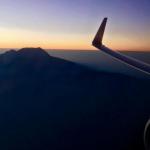© 2011 Sabrina Swenson. All Rights Reserved.
September, 2019
Kilimanjaro
It's been on my list for ages; climbing Mt. Kilimanjaro. However, in 2009 I did a thirteen day trek to Mt. Everest base camp in Nepal. It was the toughest thing I had ever physically done. Altitude sickness added to the misery. After making base camp, upon my return, I hung up my hiking boots. Climbing Kilimanjaro was pushed to the bottom of my list and all but forgotten for a decade. After looking through some old papers and finding a to-do list from years earlier, I came across it once more. Climbing the highest mountain in Africa, Kilimanjaro was beckoning. I packed my bags and hopped a plane for East Africa, before I could change my mind.
Mt. Kilimanjaro in Tanzania, East Africa, is the highest mountain on the continent. It's a large stratovolcano with three volcanic cones. Mawenzi and Shira are extinct, while Kibo, the tallest cone, is dormant and could erupt again. Uhuru Peak is the highest summit on Kibo's crater rim and is the destination for those wishing to summit. Interestingly, Uhuru in Swahili means freedom.The most recent activity on Kilimanjaro was 200 years ago. The last major eruption was estimated at 360,000 years ago. I figured chances were good I didn't have to worry about volcanic activity. The mountain has five major ecological zones. On the lowest level is cultivated bushland, followed by rainforest, heath and moorland, alpine desert and arctic summit. The mountain is known for its snow-capped peak, however, sadly, scientist warn that the snow may disappear within the next 20 years.
A guide is compulsory when attempting this feat. When doing research, the options for a tour company were overwhelming. After picking one, I next had to choose which route would be best for me. There are several routes to the summit. Most range between seven and nine days to summit and return. I mentioned to the company that I was prone to altitude sickness. They responded that the best for avoiding altitude sickness would be a seven-day Machame route, also known as the "Whiskey Route". When I asked why they call it that, the response, because it is hard! This route is more difficult and used by more serious hikers looking for a challenge. They said summiting on this route would be doable for a fit person accustom to hiking in the mountains/at altitude. I paused. The last time I hiked in the mountains was ten years ago in Nepal. I also do not live in the mountains. In fact, in the nine cities and five countries I've lived, none have been anywhere near mountains! Alas, I was not to be deterred by this fact.
After touching down on the African continent, I checked into a local hotel and rested for two days. Since I'm prone to altitude sickness, I researched all the ways to avoid it. I've suffered from altitude sickness four times in the past in Nepal, Bolivia, Peru and Tibet. My goal is to never have it again. If you've been lucky enough to avoid the affliction, consider yourself lucky. It is simply debilitating and makes you miserable. When trekking, as altitude increases, the air becomes thinner and less oxygen-saturated. If your body doesn't acclimate to high elevations properly, you may experience altitude sickness, which in serious cases can be fatal. I knew if I got it on this trek, my chances of reaching the summit would be greatly diminished. And so, I arrived two days early for my climb so I could do nothing, but rest.
On the morning of pickup, I met my obligatory guide and porters. The porters would be carrying my tent and cooking supplies. I would be carrying my backpack and the guide would be carrying his goods along with an oxygen bottle in case it was needed. An additional item was offered for the climb and it turned out to be the best $100 bucks I've ever spent; a portable toilet! Yes, I could have my very own toilet along the way. There were permanent toilets at each camp, however, it's possible there would be a lineup as there were only a few and at times, camps would have as many as 50 trekkers, plus guides and porters. The answer, pay $100 and you too, can get your private toilet with porter to carry it along the trail. It was, in fact, a simple, small camping style toilet. My porter would erect a tall, narrow tent and place the toilet inside. Well worth the money!
We headed for the base of the mountain. Upon arrival, we had to wait for a permit. In typical African fashion, it was a slow-moving process. When we finally received the ok, an hour and a half later, we were off on day one of the climb. I was very impressed to see the porters were logged as they started the trek, each indicating how many people were in their group. This was done as a conservation effort. Once finished with the trek, the porters had to produce a bag with the garbage accumulated from their group. If the garbage amount didn't match the group size, meaning rubbish was left on the mountain, they would be fined. As such, I found Kilimanjaro to be pristine and void of any trash. The only exception were two empty water bottles near camp on the last day. That was it, nothing else, not one wrapper. Very impressive.
Day one in the rain forest wasn't a particularly difficult trek, but constantly going up and up, I did need stops periodically. After around five plus hours we finally reached camp for night one. Upon arrival at each camp, we had to visit the ranger station. The ranger would produce a large book which needed to be filled out including name, age, time of arrival, company used and guide name. This is done in case someone goes missing, although, since a guide is mandatory, I'm not sure how that would happen. Once finished with the climb for the day, which averaged anywhere from three and a half to twelve hours, I was then free for the rest of the day. My routine was to first collapse in my tent for a snooze. My tent was in two sections; half for sleeping and half for eating. My porter would bring in a small, square, plastic table and chair for me for meals. Upon reaching camp for the day, usually my porters, used to the altitude, had far surpassed me on the trail and already had the tent set up. On my arrival, I'd wiggle out of my big hiking boots and dive into my sleeping bag for a rest for an hour or two. I felt slightly bad the first day for disappearing on my guide, until I saw him later and asked what he did when we got back. He said, "take a nap!" And so would be my routine after each days trek.
After a couple of hours the porter would bring me a bucket of hot water and a bar of soap so I could wash up. Lunch or dinner would follow, depending on the time of day and it was always far more than I could eat.
The days on the mountain in the strong sun at such a high altitude were glorious. Even though the temperature was low, the sun was fierce and along with my constant moving, I was the perfect temperature. The evenings, however, were freezing cold, especially the higher we climbed. Before bed one of the porters would fill my water bottle with boiling water so I could put it in my sleeping bag to keep warm, at least for a few hours. After a couple of days, I no longer bothered to change into my pajamas at night, It was simply too cold. Instead I'd just leave my trekking clothes on and would add more on top along with my silk sleeping bag liner and heavy-duty sleeping bag. It didn't work, I was still cold.
On the higher camps, one of the greatest sites was sunset and sunrise peeking out of the tent. Since I was so high, a bed of clouds were below me, resembling the ocean.
During the days, we would sometimes see lots of trekkers and other times very few and occasionally, no one. At camp, there were usually around 40-50 trekkers. Most were in their 20's and 30's, however I did see the occasional 60+ something year old.
One particularly brutal obstacle is known as the Barranco Wall, an 843 foot volcanic ledge that is first on the to-do list of day four. Using poles is discouraged as you have better luck using all four limbs to hang on. With no climbing equipment, gripping is of great importance. Once I had scrambled half way up, I stopped to have a look down at those just starting, I asked the guide if anyone had ever fallen off. The answer was yes! How the porters made it with their heavy loads bulging, I do not know. After the wall, it was several more hours of climb high, then low, only to climb high again and so on. Although brutal, especially when you’re exhausted and not used to being at high altitude, it is an excellent way to become acclimatized.
Summit day would begin at midnight of day six. The afternoon before, when I arrived into the highest camp, I had a look at the start of the trail for summit day. It seemed to go on forever and was incredibly steep. The slippery, shale-like rocks weren't going to help. I would come to realize, one step up, meant a bit of sliding back, all adding to the difficulty and time of the feat. There was no extra water at this camp, so washing was forgone to have adequate water for cooking and drinking. The entire trek my only water source was boiled water the porter had acquired from streams.
Quest for the summit started when my porter woke me around 11pm, bringing me something to eat and some ginger tea. There were many trekkers at camp and I'm sure I wasn't the only one to toss and turn before being woke. At midnight, I was ready to start. Leaving the tent the porter gave me a water bottle full of hot water so I could stuff it down the front of my jacket. It was absolutely freezing. In the cold, thin air I could see about 50 headlamps shining upward, all in the hopes of making the summit which lies at 19,341 feet. I planned to walk slowly and deliberately, stopping when I felt the need. I asked how long it should take to reach the summit. My guide stated people took anywhere from seven to twelve hours generally, that was, if they made it at all. My goal was to make the lip of the crater, known as Stella Point, by sunrise. After that, Uhuru Peak, the highest point and my destination, was another approximate hour.
My guide, with oxygen bottle in tow, was ready and proclaimed the cook was coming with us. I wondered why anyone would willingly climb to such an altitude in the middle of the night if he had already done so several times? I realized later, if I developed altitude sickness, or became too weak to continue, it would take two to carry me back down to camp. There the rescue helicopter could land safely and take me to a lower altitude. I saw helicopter landing pads at each camp. They were simply an area cleared of debris, then rocks were placed in a circle so the helicopter could find where to land. When I asked why the helicopter doesn’t just hover and drop a basket if they need to pick up someone, they stated the air is simply too thin and hovering would not be an option. And so, the person needs to be carried back to a camp and the landing area.
It wasn’t long before I wondered if I’d get frost bite on my fingers or toes. In spite of having all the right gear, my digits were painfully cold. I would stop whenever I felt the need, which was often. My guide would urge me to get going fairly soon thereafter and at the time, I found it annoying, however, I’m now happy for his nudging. Walk stop, walk stop, soon all the trekkers were spread out a great distance. Occasionally different guides would burst into song, trying to increase moral. Although I didn’t understand most of the words in their songs, I did make out the line “hakuna matata“ meaning, "no trouble" in Swahili. No trouble for the locals, perhaps, but very difficult for me!
I found the climb brutal. My heart was pounding and my lungs felt like they couldn't get enough oxygen. Exhausted, freezing and with painful digits, I kept going and told myself turning around was simply not an option. I was too tired and focused to worry about where the other trekkers were, ahead of me, behind me, I didn't know, nor did I care. I just kept putting one foot in front of the other. The only way to achieve such a monotonous, painful task. I stopped looking at my watch, as time seemed to be passing painfully slow. I saw more than one person being physically helped by their guide and several more on the ground with a look of complete exhaustion.
I don't know how six hours passed, but as a glimmer of sunrise sparked from the horizon, I saw the lip of the crater; Stella Point. A major milestone on the way to the summit! I had new inspiration. I pushed myself the last steps to the crater rim. I had made my goal of Stella Point by sunrise! A huge accomplishment. There were a few people sprawled out, sipping water. I got a picture, sat down, more of a collapsed down, had a snack, rested fast, then was up again, on my way toward the true summit, Uhuru Peak. The summit was so close, I could relax and celebrate once the peak had been reached.
As we started off on the last, approximate hour of the voyage, we saw some trekkers already returning from their successful summit. High fives were exchanged as they cheered me on stating how close Uhuru peak was. The last hour to the peak went by in a minute. I saw a large glacier to my left and realized how lucky I was that it wasn't snowing. Before I knew it, seven hours and twenty minutes after I departed my tent, I was at the peak and standing in front of the large sign proclaiming a successful summit of the highest point in Africa! A few snaps from my guide of me in front of the sign, a look around and it was time to descend. I was told from the beginning, only fifteen minutes would be allowed at the summit. The chance of altitude sickness increases exponentially the longer you linger at the top.
Once I was content in taking in the sights from the top of Africa, I turned my back and started the descent, grinning from ear to ear. I couldn't believe I didn't even need oxygen! I told my guide and porter, "lets see how fast we can descend!" Luckily I had poles as I started to run/slid down the mountain where I had just labored minutes before. I saw loads of trekkers still aiming for the summit. Some seemingly had given up and were sitting on the ground, their heads between their legs. As we descended, I saw several locals headed up. My guide said they were going to help bring down many of the trekkers who couldn't go on. There were so many, they needed help carrying them back to camp so the helicopter could pick them up. I would hear the thump of the rescue helicopter most of summit day.
We continued to run/slid down the slippery rocks and in just over an hour, I was back in my sleeping bag for a well-deserved nap. My guide said since I made good time, I could take an hour nap. I negotiated for two.
My porter woke me once again for some lunch and after, I packed up and headed further down to the next camp only three hours away. Somewhere along those last three hours of the day, my big toes started to ache. I wasn't sure if it was frostbite or the extreme pounding my feet were taking. Whereas I started my descent running at high-speed down the mountain, I was now reduced to hobbling the last hour or so before reaching camp for the night. I signed in on the rangers book and headed for my tent. After I confirmed my big toes didn't have frost bite, but rather they just had taken an extreme beating on the steep decline, I slept. After an hour, my guide arrived and said he and the porters had a song for me. I crawled out of the tent to find them all lined up with big smiles. They started singing the song presented to those who summit. It was a joyous, happy tune. They all contributed and I clapped along, thankful and appreciative to have such kind and helpful group of people helping me out along the way.
The last day was a shorter trek back through the rainforest. I continued down the wet, slippery trail and in a few hours was at the end of the climb. One last sad-looking, exhausted, dirty and limping pose in front of the final sign and I had done it! I waited at the office for my certificate of completion indicating I had successfully summited. It made me smile to see the completion age on the certificate; age 51. Why didn't I do this decades ago? Better late, then never.
And so, I will now hobble onto my next goal, my two missing big toenails as a reminder, at least until they grow back. The snows of Kilimanjaro are now behind me. A fantastic memory to revisit in my mind, for a lifetime.
























